Ghost story
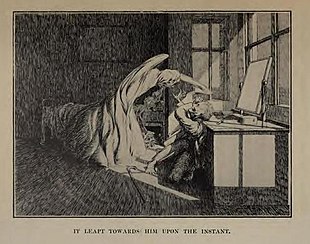
Aghost storyis any piece offiction,ordrama,that includes aghost,or simply takes as apremisethe possibility of ghosts or characters' belief in them.[1][2]The "ghost" may appear of its own accord or be summoned bymagic.Linked to the ghost is the idea of a "haunting", where a supernatural entity is tied to a place, object or person.[1]Ghost stories are commonly examples ofghostlore.
Colloquially, the term "ghost story" can refer to any kind of scary story. In a narrower sense, the ghost story has been developed as ashort storyformat, withingenre fiction.It is a form ofsupernatural fictionand specifically ofweird fiction,and is often ahorror story.
While ghost stories are often explicitly meant to scare, they have been written to serve all sorts of purposes, from comedy tomorality tales.Ghosts often appear in the narrative as sentinels orprophetsof things to come.[1]
History[edit]


A widespread belief concerning ghosts is that they are composed of a misty, airy, or subtle material.Anthropologistslink this idea to early beliefs that ghosts were the person within the person (the person's spirit), most noticeable in ancient cultures as a person's breath, which upon exhaling in colder climates appears visibly as a white mist.[3]Belief in ghosts is found in all cultures around the world, and thus ghost stories may be passed down orally or in written form.[1]
Thecampfire story,a form of oral storytelling, often involves recounting ghost stories, or other scary stories.[4]Some of the stories are decades old, with varying versions across multiple cultures.[5]Many schools and educational institutions encourage ghost storytelling as part ofliterature.[6]
In 1929, five key features of theEnglishghost story were identified in "Some Remarks on Ghost Stories" byM. R. James.As summarized by Frank Coffman for a course in popular imaginative literature, they were:[7]
- The pretense of truth
- "A pleasing terror"
- No gratuitous bloodshed or sex
- No "explanation of the machinery"
- Setting: "those of the writer's (and reader's) own day"
The introduction ofpulp magazinesin the early 1900s created new avenues for ghost stories to be published, and they also began to appear in publications such asGood HousekeepingandThe New Yorker.[8]
Literature[edit]
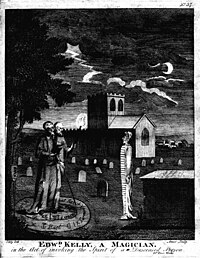
Early examples[edit]
Ghosts in the classical world often appeared in the form of vapor or smoke, but at other times they were described as being substantial, appearing as they had been at the time of death, complete with the wounds that killed them.[9]Spirits of the dead appear in literature as early asHomer'sOdyssey,which features a journey to theunderworldand the hero encountering the ghosts of the dead,[1]as well as theOld Testamentin which theWitch of Endorcalls the spirit of the prophetSamuel.[1]
The playMostellaria,by the Roman playwrightPlautus,is the earliest known work to feature a haunted dwelling, and is sometimes translated asThe Haunted House.[10]Another early account of a haunted place comes from an account byPliny the Younger(c.50 AD).[11]Pliny describes the haunting of a house inAthensby a ghost bound in chains, an archetype that would become familiar in later literature.[1]
Ghosts often appeared in the tragedies of the Roman writerSeneca,who would later influence the revival of tragedy on theRenaissancestage, particularlyThomas KydandShakespeare.[12]
TheOne Thousand and One Nights,sometimes known asArabian Nights,containsa number of ghost stories,often involvingjinn(also spelled as djinn),ghoulsandcorpses.[13][14]In particular, the tale of "Ali the Cairene and the Haunted House in Baghdad" revolves around a house haunted byjinns.[13]Other medievalArabic literature,such as theEncyclopedia of the Brethren of Purity,also contain ghost stories.[15]
The 11th centuryJapaneseworkThe Tale of Genjicontains ghost stories, and includes characters being possessed by spirits.[16]
English Renaissance theatre[edit]

In the mid-16th century, the works ofSenecawere rediscovered byItalian humanists,and they became the models for the revival oftragedy.Seneca's influence is particularly evident inThomas Kyd'sThe Spanish TragedyandShakespeare'sHamlet,both of which share a revenge theme, a corpse-strewn climax, and ghosts among the cast. The ghosts inRichard IIIalso resemble the Senecan model, while the ghost inHamletplays a more complex role.[1]Theshade of Hamlet's murdered fatherinHamlethas become one of the more recognizable ghosts inEnglish literature.In another of Shakespeare's works,Macbeth,the murderedBanquoreturns as a ghost to the dismay of the title character.[17]
In English Renaissance theatre, ghosts were often depicted in the garb of the living and even in armour. Armour, being out-of-date by the time of the Renaissance, gave the stage ghost a sense of antiquity.[18]The sheeted ghost began to gain ground on stage in the 1800s because an armoured ghost had to be moved about by complicated pulley systems or lifts, and eventually became clichéd stage elements and objects of ridicule. Ann Jones and Peter Stallybrass, inRenaissance Clothing and the Materials of Memory,point out, "In fact, it is as laughter increasingly threatens the Ghost that he starts to be staged not in armor but in some form of 'spirit drapery'." An interesting observation by Jones and Stallybrass is that "at the historical point at which ghosts themselves become increasingly implausible, at least to an educated elite, to believe in them at all it seems to be necessary to assert their immateriality, their invisibility. [...] The drapery of ghosts must now, indeed, be as spiritual as the ghosts themselves. This is a striking departure both from the ghosts of the Renaissance stage and from the Greek and Roman theatrical ghosts upon which that stage drew. The most prominent feature of Renaissance ghosts is precisely their gross materiality. They appear to us conspicuously clothed."[18]
InSpain,the legend ofCatalina Lercarostands out, a young woman from the 16th century, who committed suicide so as not to have to marry a man she did not love. From here, many people claim to see her ghost.[19]
Border ballads[edit]
Ghosts figured prominently in traditional British ballads of the 16th and 17th centuries, particularly the “Border Ballads”of the turbulentborder countrybetween England and Scotland. Ballads of this type include "The Unquiet Grave","The Wife of Usher's Well",and"Sweet William's Ghost",which feature the recurring theme of returning dead lovers or children. In the ballad"King Henry",a particularly ravenous ghost devours the king's horse and hounds before forcing the king into bed. The king then awakens to find the ghost transformed into a beautiful woman.[20]TheFlying Dutchmanwas aghost shipthat became the subject of many ghost stories.
Romantic era[edit]
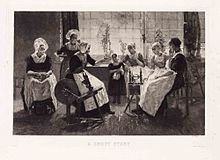
One of the key early appearances by ghosts wasThe Castle of OtrantobyHorace Walpolein 1764, considered to be the firstgothic novel.[21] However, although the ghost story shares the use of the supernatural with the Gothic novel, the two forms differ. Ghost stories, unlike Gothic fiction, usually take place in a time and location near to the audience of the story.
The modern short story emerged in Germany in the early decades of the 19th century.Kleist's "The Beggar Woman of Locarno", published in 1810, and several other works from the period lay claim to being the first ghost short stories of a modern type.E. T. A. Hoffmann's ghost stories include "The Elementary Spirit" and "The Mines of Falun".[22]
The Russian equivalent of the ghost story is thebylichka.[23]Notable examples of the genre from the 1830s includeGogol's "Viy"andPushkin's "The Queen of Spades",although there were scores of other stories from lesser known writers, produced primarily asChristmas fiction.TheVosgesmountain range is the setting for most ghost stories by the French writing team ofErckmann-Chatrian.
One of the earliest writers of ghost stories in English was SirWalter Scott.His ghost stories, "Wandering Willie's Tale" (1824, first published as part ofRedgauntlet) andThe Tapestried Chamber(1828) eschewed the "Gothic" style of writing and helped set an example for later writers in the genre.
"Golden Age of the Ghost Story"[edit]
Historian of the ghost storyJack Sullivanhas noted that many literary critics argue a "Golden Age of the Ghost Story" existed between the decline of the Gothic novel in the 1830s and the start of the First World War.[24]Sullivan argues that the work ofEdgar Allan PoeandSheridan Le Fanuinaugurated this "Golden Age".[24]
Irish author Sheridan Le Fanu was one of the most influential writers of ghost stories. Le Fanu's collections, such asIn a Glass Darkly(1872) andThe Purcell Papers(1880), helped popularise the short story as a medium for ghost fiction.[25]Charlotte Riddell,who wrote fiction as Mrs. J. H. Riddell, created ghost stories which were noted for adept use of thehaunted housetheme.[26]
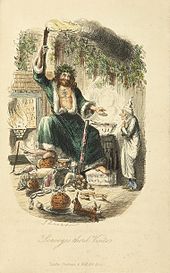
The "classic" ghost story arose during the Victorian period, and included authors such asM. R. James,Sheridan Le Fanu,Violet Hunt,andHenry James.Classic ghost stories were influenced by the gothic fiction tradition, and contain elements of folklore and psychology. M. R. James summed up the essential elements of a ghost story as, "Malevolence and terror, the glare of evil faces, 'the stony grin of unearthly malice', pursuing forms in darkness, and 'long-drawn, distant screams', are all in place, and so is a modicum of blood, shed with deliberation and carefully husbanded...".[27]
Famous literary apparitions from theVictorian periodare the ghosts ofA Christmas Carol,in whichEbenezer Scroogeis helped to see the error of his ways by the ghost of his former colleagueJacob Marley,and the ghosts of Christmas Past, Christmas Present and Christmas Yet to Come. In a precursor toA Christmas CarolDickens published "The Story of the Goblins Who Stole a Sexton".[28]Dickens also wrote "The Signal-Man",another work featuring a ghost.
Jamesian style[edit]
David Langfordhas described British authorM. R. Jamesas writing "the 20th century's most influential canon of ghost stories".[29]James perfected a method of story-telling which has since become known as Jamesian, which involved abandoning many of the traditional Gothic elements of his predecessors. The classic Jamesian tale usually includes the following elements:
- a characterful setting in an English village, seaside town or country estate; an ancient town in France, Denmark or Sweden; or a venerable abbey or university
- a nondescript and rather naïve gentleman-scholar as protagonist (often of a reserved nature)
- the discovery of an old book or other antiquarian object that somehow unlocks, calls down the wrath, or at least attracts the unwelcome attention of a supernatural menace, usually from beyond the grave
According to James, the story must "put the reader into the position of saying to himself, 'If I'm not very careful, something of this kind may happen to me!'"[30]He also perfected the technique of narrating supernatural events through implication and suggestion, letting his reader fill in the blanks, and focusing on the mundane details of his settings and characters in order to throw the horrific and bizarre elements into greater relief. He summed up his approach in his foreword to the anthologyGhosts and Marvels(Oxford,1924): "Two ingredients most valuable in the concocting of a ghost story are, to me, the atmosphere and the nicely managed crescendo.... Let us, then, be introduced to the actors in a placid way; let us see them going about their ordinary business, undisturbed by forebodings, pleased with their surroundings; and into this calm environment let the ominous thing put out its head, unobtrusively at first, and then more insistently, until it holds the stage."
Another aspect James considered a requisite was "that the ghost should be malevolent or odious: amiable and helpful apparitions are all very well in fairy tales or in local legends, but I have no use for them in a fictitious ghost story."[30]
Despite his suggestion in the essay "Stories I Have Tried to Write" that writers employ reticence in their work, many of James's tales depict scenes and images of savage and often disturbing violence.[31]
19th-century American writers[edit]
Influenced by British and German examples, American writers began to produce their own ghost stories.Washington Irving'sshort story"The Legend of Sleepy Hollow"(1820), based on an earlier German folktale, features aHeadless Horseman.It has been adapted for film and television many times, such asSleepy Hollow,a successful 1999 feature film.[32]Irving also wrote "The Adventure of the German Student"[22]andEdgar Allan Poewrote some stories which contain ghosts, such as "The Masque of the Red Death"and" Morella ".[22]
In the later 19th century, mainstream American writers such asEdith Wharton,Mary E. Wilkins Freeman[33]andF. Marion Crawford[34]all wrote ghost fiction.Henry Jamesalso wrote ghost stories, including "The Jolly Corner"andThe Turn of the Screw.[1]The Turn of the Screw,his most famous ghost story, has appeared in a number of adaptations, notably a film,The Innocents,and an opera,Benjamin Britten'sThe Turn of the Screw.
The introduction ofpulp magazinesin the early 1900s created new avenues for ghost stories to be published, and they also began to appear in publications such asGood HousekeepingandThe New Yorker.[8]
Comedies and operas[edit]
Oscar Telgmann's operaLeo, the Royal Cadet(1885) includes "Judge's Song" about a ghost at theRoyal Military College of Canadain Kingston, Ontario.[35]
Oscar Wilde's comic short story "The Canterville Ghost"(1887) has been adapted for film and television on several occasions.
In the United States, prior to and during theFirst World War,folkloristsOlive Dame CampbellandCecil Sharpcollected ballads from the people of the Appalachian Mountains, which included ghostly themes such as "The Cruel Ship's Carpenter","The Suffolk Miracle","The Unquiet Grave"and"The Wife of Usher's Well".The theme of these ballads was often the return of a dead lover. These songs were variants of traditional British ballads handed down by generations of mountaineers descended from the people of the Anglo-Scottish border region.[36]
Psychological horror[edit]
In theEdwardian era,Algernon Blackwood(who combined the ghost story with naturemysticism),[24]Oliver Onions(whose ghost stories drew onpsychological horror),[24]andWilliam Hope Hodgson(whose ghost tales also contained elements of thesea storyandscience fiction) helped move the ghost story in new directions.[24]
Kaidan[edit]
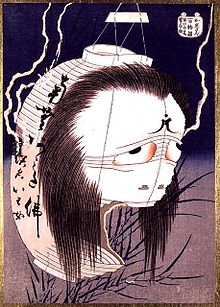
Kaidan ( quái đàm ), which literally means "supernatural tale"[37]or "weird tale",[38]is a form of Japanese ghost story.[37]Kaidan entered thevernacularwhen a game calledHyakumonogatari Kaidankaibecame popular in theEdo period.The popularity of the game, as well as the acquisition of aprinting press,led to the creation of a literary genre calledKaidanshu.Kaidan are not always horror stories, they can "be funny, or strange, or just telling about an odd thing that happened one time".[38]
Lafcadio HearnpublishedKwaidan: Stories and Studies of Strange Thingsin 1904 as a collection of Japanese ghost stories which was also adapted into afilm.[39]The book "is seen as the first introduction of Japanese superstition to European and American audiences".[37]
Modern era (1920 onward)[edit]
Ghost Storiesmagazine, which contained almost nothing but ghost stories, was published from 1926 to 1932.
Beginning in the 1940s,Fritz Leiberwrote ghost tales set in modern industrial settings, such as "Smoke Ghost" (1941) and "A Bit of the Dark World" (1962).[40]Shirley Jacksonmade an important contribution to ghost fiction with her novelThe Haunting of Hill House(1959).[1][41]
A noted modern British writer of ghost fiction isRamsey Campbell.[42]Susan Hillalso producedThe Woman in Black(1983), a ghost novel that has been adapted for stage, television and film.[2]
Noël Coward's playBlithe Spirit,later made into a1945 film,places a more humorous slant on the phenomenon of haunting of individuals and specific locations.
Film[edit]

During the late 1890s the depiction of ghost and supernatural events appear in films. With the advent of motion pictures and television, screen depictions of ghosts became common, and spanned a variety of genres. The works of Shakespeare, Dickens and Wilde have all been made into cinematic versions, as well as adaptations of other playwrights and novelists. One of the well known short films wasHaunted Castledirected byGeorges Mélièsin 1896. It is also considered as the first silent short film depicting ghost and supernatural events.[43]
In 1926 the novelTopperbyThorne Smithwas published, which created the modern American ghost. When the novel was adapted into the 1937 movieTopper,it initiated a new film genre and would also influence television.[44]After the second World War, sentimental depictions of ghosts had become more popular in cinema than horror, and include the 1947 filmThe Ghost and Mrs. Muir,which was later adapted to television with a successful 1968–70TV series.[21]Genuinepsychological horrorfilms from this period include 1944'sThe Uninvited,and 1945'sDead of Night.The filmBlithe Spirit,based on aplaybyNoël Coward,was also produced in this period.[45]1963 saw one of the first major adaptations of a ghost novel,The Haunting,based on the well known novelThe Haunting of Hill House.[21]
The 1970s saw screen depictions of ghosts diverge into distinct genres of the romantic and horror. A common theme in the romantic genre from this period is the ghost as a benign guide or messenger, often with unfinished business, such as 1989'sField of Dreams,the 1990 filmGhost,and the 1993 comedyHeart and Souls.[46]In the horror genre, 1980'sThe Fog,and theA Nightmare on Elm Streetseries of films from the 1980s and 1990s are notable examples of the trend for the merging of ghost stories with scenes of physical violence.[21]The 1990s saw a return to classic "gothic" ghosts, whose dangers were more psychological than physical. Examples of films are comedy and mystery from this period include 1984'sGhostbusters,1999'sThe Sixth SenseandThe Others.The 1990s also saw a lighthearted adaptation of the children's characterCasper the Friendly Ghost,originally popular in cartoon form in the 1950s and early 1960s, in the feature filmCasper.
Asian cinemahas also producedhorror filmsabout ghosts, such as the 1998 Japanese filmRingu(remade in the US asThe Ringin 2002), and the Pang brothers' 2002 filmThe Eye.[47]Indian ghost moviesare popular not just in India, but in the Middle East, Africa, South East Asia and other parts of the world. Some Indian ghost movies such as the comedy / horror filmManichitrathazhuhave been commercial successes, dubbed into several languages.[48]Generally the films are based on the experiences of modern people who are unexpectedly exposed to ghosts, and usually draw on traditional Indian literature or folklore. In some cases the Indian films are remakes of western films, such asAnjaane,based onAlejandro Amenábar's ghost storyThe Others.[49]
Television[edit]
In fictional television programming, ghosts have been explored in series such asGhost Whisperer,Medium,Supernatural,the television series adaptation ofThe Ghost and Mrs. MuirandRandall and Hopkirk (Deceased).In animated fictional television programming, ghosts have served as the central element in series such asCasper the Friendly Ghost,Danny Phantom,andScooby-Doo,as well as minor roles in various other television shows.[which?]
Popularized in part by the 1984 comedy franchiseGhostbusters,ghost huntinghas been popularized as a hobby wherein reportedly haunted places are explored. The ghost hunting theme has been featured inparanormalreality television series,such asA Haunting,Ghost Adventures,Ghost Hunters,Ghost Hunters International,Ghost Lab,andMost Haunted.It is also represented in children's television by such programs asThe Ghost Hunterbased on the book seriesof the same nameandGhost Trackers.[50]
The Indian television seriesAahatfeatured ghost and supernatural stories written byB. P. Singh.It was first aired on 5 October 1995 and ran for more than a decade, ending on 25 November 2010 with more than 450 episodes.[51]
See also[edit]
References[edit]
- ^abcdefghijDarrell Schweitzer(2005).The Greenwood Encyclopedia of Science Fiction and Fantasy: Themes, Works, and Wonders.Westport, CT: Greenwood. pp. 338–340.
- ^ab"Ghost Stories" inMargaret Drabble(ed.),Oxford Companion to English Literature.Oxford, Oxford University Press, 2006.ISBN9780198614531(p. 404-5).
- ^J. Gordon Melton (1996).Encyclopedia of Occultism & Parapsychology.Gale Group.ISBN978-0-8103-5487-6.
- ^Vassler, Bill."Campfire Stories: The Art Of The Tale".Westside Toastmasters.Retrieved12 August2014.
- ^Gordon, Lauren (16 July 2014)."9 Scary Campfire Stories That'll Make You Drop Your S'mores".ABC News.Retrieved12 August2014.
- ^Carey, Joanna (17 February 2004)."Ghouls for schools".The Guardian.Guardian News and Media.Retrieved13 August2014.
- ^Coffman, Frank."Excerpts From" Some Remarks on Ghost Stories "".Archived from the original on February 14, 2009.Retrieved20 July2012.
{{cite web}}:CS1 maint: unfit URL (link) - ^abCarpenter, Lynette; Kolmar, Wendy K.Ghost Stories by British and American Women: A Selected, Annotated Bibliography.Taylor & Francis. pp. xxii.
- ^Finucane, R. C. (1984).Appearances of the Dead: A Cultural History of Ghosts.Prometheus Books. pp. 4, 16.ISBN978-0879752385.
- ^D. Felton (2010).Haunted Greece and Rome: Ghost Stories from Classical Antiquity.University of Texas Press. pp. 50–51.ISBN978-0-292-78924-1.
- ^Jaehnig, K.C. (1999-03-11)."Classical ghost stories".Southern Illinois University. Archived fromthe originalon September 8, 2007.Retrieved2007-09-19.
- ^Braund, Susanna (28 March 2013). "Haunted by Horror: The Ghost of Seneca in Renaissance Drama". In Buckley, Emma; Dinter, Martin T. (eds.).A Companion to the Neronian Age.pp. 425–443.doi:10.1002/9781118316771.ch24.ISBN9781118316771.
- ^abYuriko Yamanaka, Tetsuo Nishio (2006).The Arabian Nights and Orientalism: Perspectives from East & West.I.B. Tauris.pp.83–84.ISBN978-1-85043-768-0.
- ^Hamori, Andras (1971). "An Allegory from the Arabian Nights: The City of Brass".Bulletin of the School of Oriental and African Studies.34(1): 9–19 [10].doi:10.1017/S0041977X00141540.S2CID161610007.
- ^Ian Richard Netton (1991).From the introduction ofMuslim Neoplatonists: An Introduction to the Thought of the Brethren of Purity.Edinburgh University Press. p. 59.ISBN978-0-7486-0251-3.
- ^Smith, Tom (August 6, 2014)."Hyper Japan hails digital-age 'Genji' opera".The Japan Times.RetrievedAugust 12,2014.
- ^Graves, Zachary (2011).Ghosts the complete guide to the supernatural.Eastbourne, UK: Canary Press. p. 182.ISBN9781908698124.
- ^abJones, Ann Rosalind; Stallybrass, Peter (2000).Renaissance Clothing and the Materials of Memory.Cambridge University Press. p. 248.ISBN978-0521786638.RetrievedAugust 16,2014.
- ^Ghosts. Appearances of the Dead and Cultural Transformation. Finucane, R. C. (1996).
- ^Helen Child Sargent; George Lyman Kittredge (1904).English and Scottish Popular Ballads edited from the Collection by Francis James Child.New York: Houghton Mifflin.
- ^abcdNewman, Kim, ed. (1996).BFI Companion to Horror.London: Cassell. p. 135.ISBN978-0304332168.
- ^abcAndrew Barger, "Introduction:All Ghosts are Grey" in Barger (editor),The Best Ghost Stories 1800–1849: A Classic Ghost Anthology.Bottletree Books LLC, 2011.ISBN1-933747-33-1,(pp. 7-12)
- ^Pamela Davidson.Russian Literature and Its Demons.Berghahn Books, 2000.ISBN9781571817587.Page 59.
- ^abcdeJack Sullivan (1986)."Golden Age of the Ghost Story" in The Penguin Encyclopedia of Horror and the Supernatural.Viking Press. pp.174–6.ISBN978-0-670-80902-8.
- ^J. L. Campbell Sr. (1985). "J. S. Le Fanu". InE. F. Bleiler(ed.).Supernatural Fiction Writers.New York: Scribner's. p. 88.ISBN978-0-684-17808-0.
- ^J. L. Campbell Sr., "Mrs. J. H. Riddell", in Bleiler, ed.,Supernatural Fiction Writers.
- ^James, M. R. (December 1929).Some Remarks on Ghost Stories.The Bookman. pp. 55–56.
- ^Barger, Andrew (2015).Middle Unearthed: The Best Fantasy Short Stories 1800-1849.Bottletree Books LLC. p. 13.ISBN978-1-933747-53-8.
- ^David Langford, "James, Montague Rhodes", inDavid Pringle,ed.,St. James Guide to Horror, Ghost & Gothic Writers(London: St. James Press, 1998).ISBN1-55862-206-3
- ^abJames, M.R., "Preface toMore Ghost Stories of an Antiquary".In Joshi, S.T., ed. (2005).Count Magnus and Other Ghost Stories: The Complete Ghost Stories of M.R. James, Volume 1,pt. 217. Penguin Books.
- ^Punter, David (2003). "The modern gothic".The literature of terror: a history of Gothic fictions from 1765 to the present day.London: Longman. p. 86.ISBN978-0582290556.
Although James conjures up strange beasts and supernatural manifestations, the shock effect of his stories is usually strongest when he is dealing in physical mutilation and abnormality
- ^Sleepy HollowatBox Office Mojo.Retrieved 29 January 2009.
- ^Benjamin Fisher, "Transitions from Victorian to Modern: The Supernatural Stories of Mary Wilkins Freeman and Edith Wharton" in: Robillard, Douglas, ed.American Supernatural Fiction: From Edith Wharton to the Weird Tales Writers.New York: Garland, 1996. (pp. 3-42).ISBN0-8153-1735-2
- ^Douglas Robillard, "The Wandering Ghosts of F. Marion Crawford" in: Robillard, Douglas, ed.American Supernatural Fiction: From Edith Wharton to the Weird Tales Writers.New York: Garland, 1996. (pp. 43-58).ISBN0-8153-1735-2
- ^Cameron, George Frederick (1889).Leo, the Royal cadet.[Kingston, Ont.?: s.n.ISBN9780665065514.
- ^Campbell, Olive Dame; Sharp, Cecil James (1917).English Folk Songs From The Southern Appalachians.New York: G. Putnam's Sons.
- ^abcFoutz, Scott."Kaidan: Traditional Japanese Ghost Tales and Japanese Horror Film".Archived fromthe originalon 3 October 2014.Retrieved14 August2014.
- ^ab"What are Kaidan".Hyakumonogatari Kaidankai.2010-08-18.Retrieved14 August2014.
- ^"Kwaidan", byBrian Stableford,inFrank N. Magill,ed.,Survey of Modern Fantasy Literature,Vol 2. Englewood Cliffs, NJ: Salem Press, Inc., 1983,ISBN0-89356-450-8(pp. 859-860).
- ^Landon, Brooks (1983). "The Short fiction of Leiber". In Magill, Frank N. (ed.).Survey of Modern Fantasy Literature, Vol 4.Englewood Cliffs, NJ: Salem Press, Inc. pp. 1611–1615.ISBN978-0-89356-450-6.
- ^Sullivan, Jack. "Shirley Jackson". In Bleiler (ed.).Supernatural Fiction Writers.pp. 1031–1036.
- ^Joshi, S. T. (2001).Ramsey Campbell and Modern Horror Fiction.Liverpool: Liverpool University Press. pp.53–63.ISBN978-0-85323-765-5.
- ^Babbis, Maurice."The True Origin of the Horror Film".Emerson.edu.Emerson College. Archived fromthe originalon 18 April 2013.Retrieved11 August2014.
- ^FILM; A Fanciful, Haunting Tale of Influence - The New York Times
- ^"Blithe Spirit".British film institute. Archived fromthe originalon 12 July 2012.Retrieved11 August2014.
- ^Chanko, Kenneth M. (August 8, 1993)."FILM; When It Comes to the Hereafter, Romance and Sentiment Rule".The New York Times.Retrieved2009-01-29.
- ^Rafferty, Terence (June 8, 2003)."Why Asian Ghost Stories Are the Best".The New York Times.Retrieved2009-01-29.
- ^Mohamed, Shoaib (September 24, 2007)."The Bus Conductor Turned Superstar Who Took the Right Bus to Demi".Behindwoods.Retrieved2010-03-17.
- ^"Anjaane – The Unknown".Indiafm.December 30, 2005. Archived fromthe originalon March 8, 2008.Retrieved2010-03-17.
- ^Williams, Karen (2010)."The Liveness of Ghosts: Haunting and Reality TV".In Blanco, María del Pilar; Peeren, Esther (eds.).Popular ghosts: the haunted spaces of everyday culture.New York: Continuum. pp. 149–160.ISBN9781441163691.
- ^"Hello darkness, my old friend..."Indian Express.Indian Express Newspapers (Bombay) Ltd. 3 November 1997. Archived fromthe originalon 12 January 2014.Retrieved17 March2010.
Further reading[edit]
- Bailey, Dale.American Nightmares: The Haunted House Formula in American Popular Fiction.Bowling Green, OH: Popular Press, 1999.ISBN0-87972-789-6.
- Felton, D. (1999).Haunted Greece and Rome: Ghost Stories from Classical Antiquity.University of Texas Press.ISBN978-0-292-72508-9.
- Ashley, Mike, ed.Phantom Perfumes and Other Shades: Memories ofGhost StoriesMagazine.Ash-Tree Press, 2000.
- Joynes, Andrew, ed.Medieval Ghost Stories: An Anthology of Miracles, Marvels and Prodigies.Woodbridge: Boydell Press, 2003.
- Locke, John, ed.Ghost Stories: The Magazine and Its Makers, Volumes 1 & 2.Off-Trail Publications, 2010.
- Sullivan, Jack.Elegant Nightmares: The English Ghost Story from Le Fanu to Blackwood,Ohio University Press, 1978.ISBN0-8214-0569-1.
- Brewster, Scott, and Luke Thurston, ed.The Routledge Handbook to the Ghost Story.New York: Routledge, 2018.
- O'Brian, Helen Conrad, and Julie Anne Stevens, ed.The Ghost Story from the Middle Ages to the 20th Century: A Ghostly Genre.Dublin: Four Courts Press, 2010.
- Briggs, Julia,Night Visitors: The Rise and Fall of the English Ghost Story.London: Faber, 1977.

